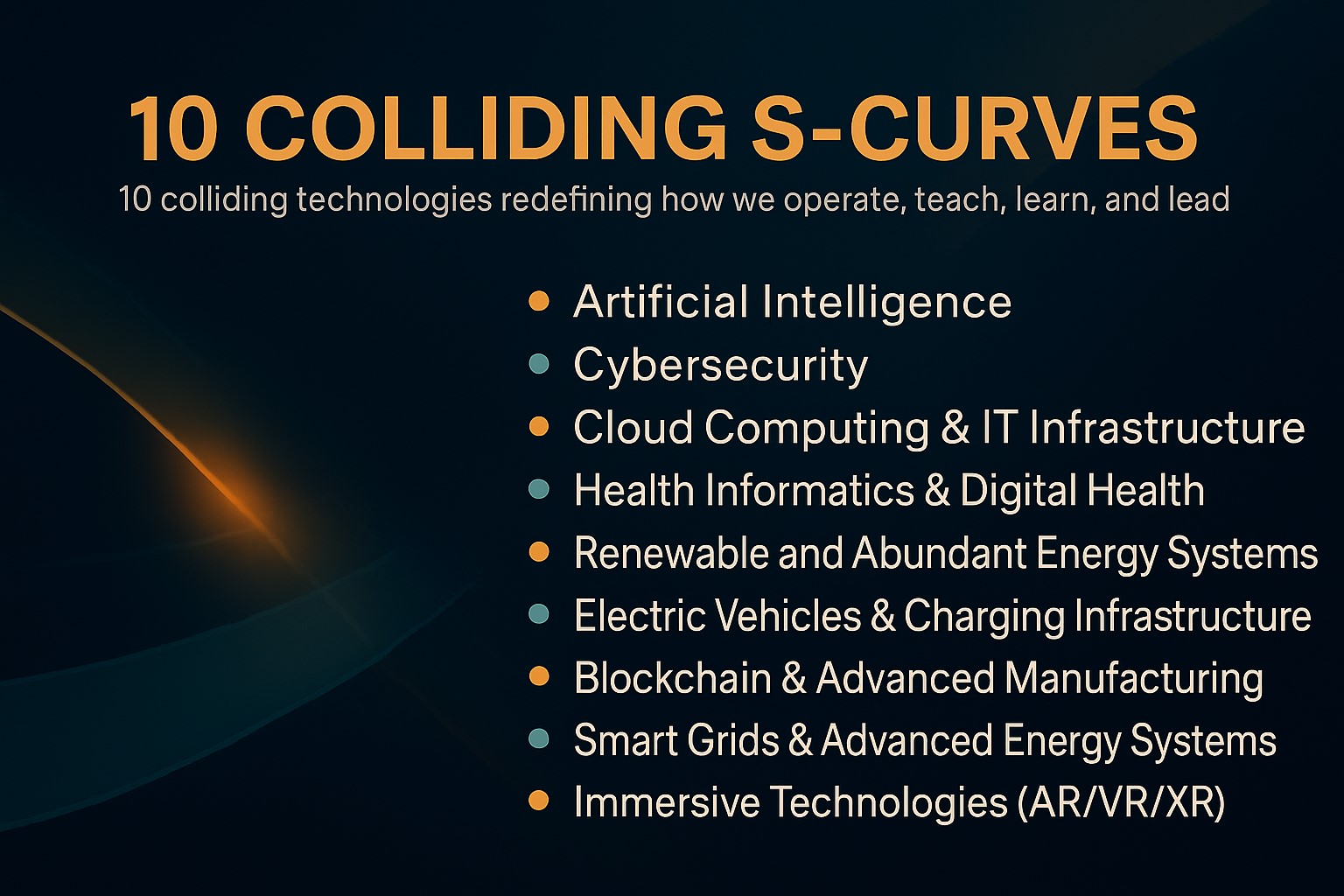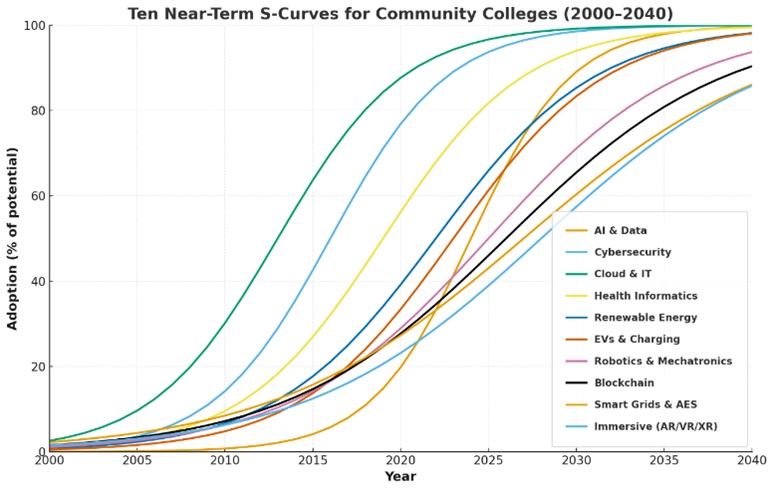Ten S-Curves Shaping the Future of Community Colleges
Colliding S Curves Week 2
By Rick Aman onTen emerging technologies redefining how we operate, teach, learn, and lead
The greatest danger in times of turbulence is not the turbulence; it is to act with yesterday’s logic — Peter Drucker
Change in higher education no longer moves in straight lines. It advances in overlapping waves, each one gathering speed as another begins to slow. The hardest part of leadership isn’t managing a single disruption; it’s guiding an organization through the intersections where multiple forces collide. In my work with governing boards, I’ve seen how these moments test not only strategy but also trust where clarity, communication, and shared vision become the real measures of leadership.
Today, those intersections are everywhere. Artificial intelligence, immersive learning, blockchain credentials, and cloud infrastructure are reshaping how colleges operate and how students prepare for work that doesn’t yet exist. Add to that the accelerating curves of renewable energy, advanced manufacturing, cybersecurity, and digital health, and the pace becomes exponential. The future isn’t arriving in sequence it’s arriving all at once.
For community and technical colleges, this convergence defines a new strategic frontier. As Arthur Levine and Scott Van Pelt describe in The Great Upheaval, higher education is being reshaped by forces that challenge its very identity, who it serves, how it teaches, and what credentials mean. Relevance will depend not only on adapting to each S-curve but on seeing how they interact where one technology amplifies another, and where traditional models of teaching, funding, and credentialing begin to bend. Understanding these ten technology-driven S-curves is the first step toward shaping a preferred future rather than reacting to someone else’s.
The Ten Technology S-Curves Shaping the Workforce and Society

None of these technologies stand alone, they amplify one another. AI drives analytics: analytics depend on cloud infrastructure; broadband enables immersive learning; and cybersecurity underpins them all. These collisions create turbulence but also immense possibility.
During board retreats, I often illustrate this visually: layered S-curves rising and intersecting across time. Each curve represents a domain of change in teaching, infrastructure, workforce, or skills. The responsibility of leadership is not to ignore the curves but to recognize where they converge, that’s where strategy lives.

Artificial Intelligence and Automation AI is redefining productivity and problem-solving across every sector, creating a world where continuous learning, adaptation, and ethical use of intelligent systems determine competitiveness.
Cybersecurity and Digital Ethics As society becomes fully digital, safeguarding data and integrity has become a civic responsibility, anchoring public trust and protecting the infrastructure of modern life.
Cloud and IT Infrastructure Global connectivity and distributed computing form the backbone of economic resilience, demanding leaders who can balance access, efficiency, and security at scale.
Health Informatics and Digital Health Data-driven healthcare is transforming longevity and quality of life, requiring a workforce fluent in analytics, telemedicine, and ethical management of personal health data.
Renewable and Abundant Energy Systems AI adoption is driving the need for vastly greater energy production. Clean-energy innovation and energy storage is reshaping geopolitics and economies, calling for technically skilled workers who can build and maintain resilient energy infrastructure.
Electric Vehicles and Charging Infrastructure The shift to electrified mobility will redefine transportation networks, manufacturing, and urban planning creating millions of new technical and service roles.
Blockchain Credentials and the Tokenization of the World Decentralized verification is building a new layer of digital trust, enabling individuals to own and exchange value, identity, and credentials securely across society.
Robotics and Advanced Manufacturing
Automation and collaboration between people and machines are reshaping industry; future roles will prize adaptability, oversight of automated systems, and digital craftsmanship.Data Analytics and Predictive Insights In every field, the ability to translate complex data into strategic foresight will guide smarter decisions, policies, and innovations across society.
Immersive Technologies (Augmented and Virtual Reality) Immersive platforms are redefining how people learn, design, and connect, blending creativity and technology to shape experiences across education, commerce, and culture.
Opportunity or Threat?
Every S-curve carries both promise and peril. On the ascent, it offers innovation and growth; on the descent, obsolescence. Whether technology becomes opportunity or threat depends on how leaders engage it. Colleges that experiment thoughtfully gain early insight and workforce advantage. Those that wait for certainty often find themselves catching up at double the cost. Curiosity, not caution, is the competitive edge.
The simple discipline I share with boards is the insight to review each technology through a SWOT (Strengths, Weaknesses, Opportunities, Threats) lens. What are our strengths in adoption? What weaknesses limit us? Which opportunities align with mission? What threats demand attention? The future rewards those who keep that conversation alive.
The Board’s Role: Environmental Scanning and Sense-Making
Governing boards are uniquely positioned to see these patterns first. Their distance from operations provides perspective, but only if it’s informed. That’s why environmental scanning is now a core competency of modern governance.
A comprehensive scan looks across political, economic, social, technological, environmental, and legal trends (the PESTEL model). When coupled with institutional analytics, it becomes a strategic radar system detecting early signals that should shape budgets, partnerships, and academic focus.
Boards should dedicate at least one annual session to technology foresight: Which emerging tools align with our mission? Which demand faculty development? Where can shared infrastructure reduce costs and increase access? Futuring is not prediction—it’s preparedness.
Navigating the Intersections: A Leadership Framework
To guide colleges through converging technologies without being overwhelmed:
Identify the Forces. Map the emerging S-curves shaping your institution: AI, automation, robotics, blockchain and visualize how each influences mission and operations. Clarity builds shared understanding across leadership levels.
Find the Intersections. Spot where these forces overlap—AI with analytics, broadband with workforce, secure systems, use of automation for efficiency, and design to reveal opportunities and tensions that demand attention.
Assess Readiness and Define the Preferred Future. Evaluate where to lead, where to collaborate, and where to build capacity. Then describe what success looks like three to five years ahead if technology, mission, and workforce needs align.
Align Resources to the Vision. Budgets, ethics, policies, and partnerships should follow the preferred future—not drive it. True innovation emerges when governance, strategy, and resources move in concert.
Colleges that embed adaptability into their systems not just their programs will remain relevant regardless of how the next wave of disruption unfolds.
Closing Reflection
The challenge before community colleges isn’t mastering any single technology, it’s managing their intersections. Each innovation carries risk; together they define a moment of extraordinary possibility. Our task as leaders is to help boards, faculty, and communities see the full picture to connect the dots before they connect themselves. Futuring isn’t about forecasting gadgets; it’s about framing choices. When change arrives, it should find a college already in motion—aligned, adaptive, and anchored in purpose.
----
At Aman and Associates, we help boards and executive teams navigate these converging S-curves through Futuring Retreats and Preferred Future Planning. If your college is ready to map its own technology landscape and identify the intersections that matter most, I’d welcome a conversation. Together, we can turn disruption into direction.
Rick Aman, PhD Aman and Associates | rick@rickaman.com | rickaman.com/articles
